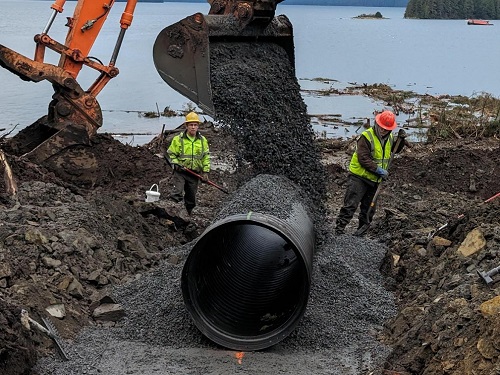The Federal Highway Administration has issued nearly $830 million in discretionary grants to 80 projects nationwide to help states and local communities strengthen surface transportation systems such as roads, bridges, ports, intercity rail, pedestrian facilities, and transit systems – making them more resilient to natural disasters and extreme weather events, such as flooding and heat waves.
[Above photo by the Alaska DOT&PF]
The agency said funding comes from its Promoting Resilient Operations for Transformative, Efficient, and Cost-saving Transportation or “PROTECT” discretionary grant program, which complements $4.3 billion worth of PROTECT formula funding already flowing to states to support such projects.

Increasing the resilience of surface transportation assets helps reduce short- and long-term costs by minimizing future needs for maintenance and reconstruction, noted FHWA Administrator Shailen Bhatt.
“This investment … will ensure our infrastructure is built to withstand more frequent and unpredictable extreme weather, which is vitally important for people and businesses that rely on roads and bridges being open to keep our economy moving,” he explained in a statement.
The FHWA added that the PROTECT discretionary funding going to those 80 transportation projects is divided up between four different types of grants:
- Planning Grants: Twenty-six projects will receive approximately $45 million to develop resilience-improvement plans, resilience planning, predesign and design activities, and capacity-building activities, as well as evacuation planning and preparation initiatives.
- Resilience Improvement Grants: Thirty-six projects will receive approximately $621 million to enhance the resilience of existing surface-transportation infrastructure by improving drainage, relocating roadways, elevating bridges, or incorporating upgrades to allow infrastructure to meet or exceed design standards.
- Community Resilience and Evacuation Routes: Ten projects will receive approximately $45 million for improvements to enhance the resilience of evacuation routes or to enhance their capacity and add redundant evacuation routes.
- At-Risk Coastal Infrastructure: Eight projects will receive approximately $119 million to protect, strengthen, or relocate coastal highway and non-rail infrastructure.
Some 19 projects overseen by state departments of transportation and/or related entities are receiving funding via this first round of PROTECT discretionary grants:

- The Alaska Department of Transportation and Public Facilities will receive over $40.5 million to address damage from Typhoon Merbok and provide resilience upgrades to infrastructure in four disadvantaged and rural communities in Western Alaska.
- The California Department of Transportation will receive $4.1 million to develop a plan that identifies evacuation route improvements for State Routes 96 and 169, focusing on resilience elements against wildfire, extreme weather impacts, and other climate related events. This project will improve and protect access for disadvantaged communities, including Hoopa, Karuk, Yurok and Tsnungwe Tribes, to obtain goods, services, and medical care, connection to cultural resources, and emergency access in and out of the region.
- The District Department of Transportation in Washington, D.C., will receive $1 million to conduct an engineering study and develop an implementation plan to improve flood resilience of the Nannie Helen Burroughs Avenue NE underpass beneath DC-295. The roadway provides a critical access route for several surrounding historically disadvantaged neighborhoods that can be cut off during heavy rain events. The study will also investigate opportunities for economic development while addressing flooding risks.
- The Delaware Department of Transportation will receive over $15 million to raise State Route 9 at Taylors Bridge to preserve access that is gradually diminishing as sea level rise overtakes the road and disrupts travel daily. The project will make additional bridge improvements including widening sidewalks, expanding road shoulders, reducing the number of piers from nine to three to improve water flow, and installing retaining walls to reduce wetlands impacts.
- The Florida Department of Transportation will receive over $18 million to reconstruct a portion of State Route 907 in Miami Beach to be more resilient to worsening flooding events due to high tides and sea level rise. The project will raise the pavement elevation, install two new pump stations and larger drainage conduits, and add a new multimodal pathway and sidewalk for bicyclists and pedestrians.
- The Hawaii Department of Transportation will receive $2.4 million to install a coastal barrier to prevent erosion from destabilizing the northbound lane of Kamehameha Highway, to ensure the most threatened location of the highway road, which links the Ko’olauloa district and the Honolulu metro area, is protected from waves and erosion. The agency is also receiving over $2.8 million to replace 1,000 feet of an existing rock fall impact fence to provide protection from rock falls on a heavily travelled corridor of Kamehameha Highway. The new fence will be 10 times stronger than the current fence and will reduce damage to the highway and disruption to road users, including emergency vehicles in rural Oahu.
- The Illinois Department of Transportation will receive over $8.6 million to upgrade sewers along Harrison Street to reduce flooding on I-290 and protect local roadways and homes in the Village of Maywood from severe flooding impacts. The project will alleviate stress on the Metropolitan Water Reclamation District of the Greater Chicago system during high rainfall events and is part of a greater Eisenhower Expressway project that will repair the corridor to meet current and future challenges of a growing population facing climate change.
- The Michigan Department of Transportation will receive $12 million to upgrade storm drainage and surface infrastructure to reduce future flooding on 28th Street, an important transportation and freight corridor in Grand Rapids. The project proposes replacing the aging pump station, replacing approximately a half mile of poor roadway pavement, and adding rain gardens to capture storm runoff along the street.
- The Minnesota Department of Transportation will receive over $2.5 million to address two critical slope failures that threaten to close portions of Highway 11 along the Rainy River; realigning 1.2 miles of the highway about 150 feet to the west, removing the roadway from the slide areas, and completing slope stabilization work. The agency is also receiving over $13.7 million to install 24 miles of snow fence across 38 sites to address snow control along nearly 120 miles of I-94 between the cities of Moorhead and Alexandria. The project will mitigate the worst snow traps along the I-94 corridor, improving safety, reducing wintertime maintenance needs, and improving reliability of the heavily traveled and economically vital corridor.
- The Mississippi Department of Transportation will receive $4.8 million to expand the contraflow route and install new signage, gates at exit ramps, and mile markers for improved traffic flow along two major hurricane evacuation routes between Mississippi and Louisiana. The project will improve the safety, efficiency and resiliency within two critical segments of hurricane evacuation infrastructure in Mississippi, along Interstate 55, the main north-south corridor through western Mississippi, and Interstate 59, which runs northeast from Slidell, Louisiana.
- The North Carolina Department of Transportation will receive over $1.8 million to conduct a study along an 11-mile stretch of Highway 12 between Oregon Inlet and Rodanthe on Pea Island. The goal of the study is to develop long-term, comprehensive plans for keeping the roadway passable during and following major storm events. The project will identify future construction projects and help streamline environmental reviews. The agency will also receive over $1.8 million to reinforce the shoulder and embankments at the Lumber River crossing along US 74 between Boardman and Orrum. The improvements are necessary to prevent flooding, roadway deterioration and damage that the bridge sustains when flooded after heavy storms. US 74 is a major east-west evacuation route connecting coastal Wilmington to Charlotte and is essential to ensuring that local communities have access to emergency and community services during extreme weather events.
- The New Hampshire Department of Transportation will receive over $20.2 million to reconstruct coastal erosion protections along three miles of Route 1A between North Hampton and Rye. Those improvements will significantly reduce road closures and roadway clean-up in coastal communities vulnerable to the increasing intensity and frequency of coastal storms as well as rising sea levels.
- The New York State Department of Transportation will receive $1.65 million to develop and coordinate emergency response plans for a four-county region in Western New York, including Erie, Niagara, Cattaraugus, and Chautauqua. The project will examine vulnerabilities around roadway and transit operations as well as maintenance practices during severe winter snowstorms made more challenging by lake-effect snow. One goal is to identify ways to consistently and proactively communicate with residents about openings, closures, and travel conditions.
- The Oregon Department of Transportation will receive $6.1 million to replace an existing culvert under Highway 101 with a new bridge over Butte Creek that will better handle the effects of flooding and rising sea levels. Located between Tillamook and Lincoln City, the project also will include a new stream-crossing feature to allow unrestricted migration of native migratory fish.
- The Pennsylvania Department of Transportation will receive $6.7 million to increase the height of the floodwall that protects Interstate 376 in downtown Pittsburgh from flooding by the Monongahela River. The project will significantly reduce highway closures, delays, traffic congestion, and the associated risks and costs of flooding while increasing safety for travelers and emergency personnel.
- The Rhode Island Department of Transportation will receive $26 million to manage stormwater drainage, reduce roadway flooding, and address climate change vulnerabilities at 97 locations across the state. The project will enhance drainage capacity, improve water quality, reduce runoff, and increase green space in watershed areas. The agency will also receive $750,000 to develop a coastal management plan that allows the shoreline in the Town of Warren to move inland. The project will address alternatives for three state roadway resurfacing projects along RI-136 within the coastal community. The project will help the community make “smart transportation investments” that address vulnerabilities in the Market Street and Metacom Avenue corridors.
- The Utah Department of Transportation will receive over $5.4 million to make stormwater drainage improvements along 53 miles of Interstate 15 in rural Iron and Washington counties. The project will make improvements to a corridor critical to interstate commerce and will reduce the impact of extreme weather events, flash-flooding, and wildfires in the southwest corner of the state.
- The Virginia Department of Transportation will receive over $5.4 million to install a weather and traffic monitoring system that will facilitate emergency evacuations due to extreme weather events in Virginia’s Tidewater and Chesapeake region. The project will include the use of flood sensors, stream gauges, and traffic cameras to promote data-driven decisions in hazardous conditions, including flood, wind, fire, and landslides.
- The West Virginia Department of Transportation will receive nearly $3.3 million to reconstruct 1,350 feet of State Route 39 (WV 39) and raise the roadway about seven feet to place it outside the flood zone of the Cherry River. WV 39 is a critical corridor in the transportation network of the area and serves as the main east-west evacuation route for the City of Richwood, an isolated, sparse, rural community that has been the center of the lumber industry.



